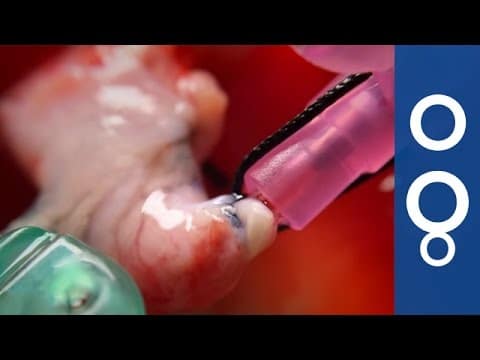On Futuris this week we look at the growing science of generating tailor-made bones to transplant into humans. Traditional transplants have been around for many years, but the procedure would be so much easier if doctors could easily regenerate specific bone tissue for an individual patient.
Professor Michael Rasse is the head of the clinic of maxillofacial surgery at the University of Innsbruck in Austria. His team specialises in reconstructing facial bones damaged by serious accidents or cancer.
The traditional procedure is to take bone from somewhere else on the patient’s body and use that tissue to reconstruct the damaged area.
“It’s not ideal,” said Professor Rasse. “Because the bone that you have harvested will not regrow. You have loss of muscle function, loss of sensitivity, you have scars – and the surgery takes quite a long time”.
Synthetic implants or tissue from other donors can be rejected by the patient’s body. A European research project at Wuerzberg in Germany is working on a treatment aimed at overcoming these these drawbacks.
One of the team working at the Fraunhofer Translational Centre is Oliver Pullig, a researcher in biotechnology:
“The big advantage of our method is that we’re using the body’s own cells, so there is no immune reaction against foreign products, and it’s accepted by the body perfectly.”
Scientists at the centre are trying to grow tailored bone implants in the lab. First, a pig intestine is treated to remove all pig cells. The blood vessels are accurately preserved. Then, the clean collagen structure is filled with bone replacement materials and the patient’s stem cells.
“The pig intestine is the right material for several reasons,” said Christoph Rücker, another member of the team. “First, its decellularization process is very well established, and second, it’s the right size, as we’re looking for implants in the range of few centimetres.These granules are beta-tri-Calcium phosphate, a material which is similar to bone – so called bone replacement material, seeded with stem cells that we get from the bone marrow of the patient.“
The preparation of the transplant is finalised in the incubator providing the necessary conditions for the bone to grow. Researchers have developed an extensive set of tools and materials to treat various bone defects at different ages, and Christoph Rücker says the future is looking positive:
“We conducted pre-clinical trials, and are hoping to successfully start the clinical trials by the end of the year. If it works out, in the future this will be the way towards clinical use.”
Looking even further ahead there is also the potential to make tailored bones using 3D printers. That’s what researchers are experimenting with a DiaCoating in Watten, Austria.
One of the scientists there is physicist Doris Steinmüller-Nethl:
“In the future, surgeons would use 3D printers at their clinics to produce implants immediately after the patient arrives and gets an MRI scan – so each patient will be receiving a personalised implant.”
Researchers are working on combining ceramics and polymers with diamond nano-particles to print biocompatible bone substitutes of any required size and shape.
It’s a fascinating area of medical science that cound benefit countless people in the near future.





